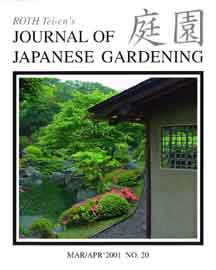|
The Shiosai Project
 In 2002 JOJG
launched a bold new initiative called The Shiosai Project. This
ground breaking endeavor consists of ongoing research
to identify Japan's very best Sukiya Living Environments. The project,
which uses the factor of "quality" to compare and rank gardens, is the first
of its kind. In the past, Japanese scholars compiled many lists of
gardens famous for their size or historical significance. But never
before has anyone tried to rank them according to their beauty or
effectiveness.
In 2002 JOJG
launched a bold new initiative called The Shiosai Project. This
ground breaking endeavor consists of ongoing research
to identify Japan's very best Sukiya Living Environments. The project,
which uses the factor of "quality" to compare and rank gardens, is the first
of its kind. In the past, Japanese scholars compiled many lists of
gardens famous for their size or historical significance. But never
before has anyone tried to rank them according to their beauty or
effectiveness.
Here are a few commonly-asked questions about the Shiosai Project:
1. Why that name? For years the project's founder, Douglas M. Roth, lived near a delightful, high-quality Japanese garden in Hayama called Shio-sai Park (see cover photo, above). That garden has rarely, if ever, been mentioned in Japanese garden literature, despite the fact that it was the Taisho Emperor's home for the last ten years of his life. When a garden as nice as Sho-sai Koen gets such scant attention, it proves that many of Japan's very best gardens are going unnoticed.
2. Why is the project considered groundbreaking? JOJG is the only source to have ever compiled this kind of quality-based ranking of Sukiya Living Environments. Previous listings by Japanese experts were not ranked, and they were oriented toward large or famous gardens.
3. Why does JOJG place so much emphasis on that one word, "quality"? Too much attention has been paid to certain gardens simply because they are large, old, or historical in nature. The Shiosai Project is an effort to bypass those destinations and to focus instead on gardens that actually succeed at being beautiful, functional, and satisfying. The terms "high-quality" and "high-quality living environment" help everyone understand this goal.
4. What do you mean by "high-quality"? The term has different meanings to each individual. Participating experts are encouraged to make choices based on their own definition of the term.
5. Who is participating in this project? JOJG has solicited feedback from numerous experts who regularly contribute articles to JOJG.
6. What if they think a "large" or "historically-significant" garden is actually a high-quality one? That's fine. The experts are free to rank the gardens however they feel appropriate. There are certainly some gardens that are both famous and of high quality.
7. I haven't heard of some of the gardens on the Shiosai Project's "Top-25 rankings. That's the idea. We're more than happy to identify gardens that aren't on the well-worn tourist map.
---------------------------------------------------------------
Each year JOJG publishes a ranked listing of the current "Top-25" gardens. Here are some results from recent years:
---------------------------------------